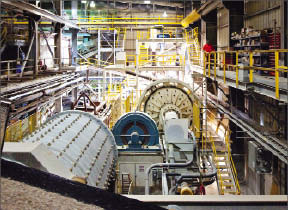Born of two established metals companies as a pure smelting play in 2007, Brussels-listed Nyrstar has since grabbed a commanding position in the zinc supply chain with no signs of slowing down.
The major shift came in 2009, when zinc prices dropped to US50¢ per lb. and the company bought mines to tap into the greater profit-margin potential. The company now has six smelters, nine wholly owned mines and two advanced development projects, with an appetite for more.
First came the Mid-Tennessee zinc mine complex that the company bought for $15.7 million, which a bankrupt Strategic Resource Acquisition had just spent $150 million refurbishing, and which perfectly complemented Nyrstar’s nearby Clarksville smelter. Then the company snapped up 85% of the Coricancha mine in Peru for US$15 million while it was on care and maintenance, bought a 20% stake in Ironbark Zinc and its large Greenland zinc deposit for US$4.5 million and rounded out 2009 with an East Tennessee zinc mine purchase from then-private Glencore International for US$126 million.
Hardly slowing down in 2010, the company secured 1.25 million tonnes of zinc concentrate from Talvivaara Mining in Finland for US$335 million, bought the remaining 15% of Coricancha for US$4.8 million, increased its stake in Greenland-focused Ironbark by 10% for US$13 million, acquired two more mines in Peru — Contonga and Pucarrajo — for US$33 million and led a US$282-million bid for CBH Resources, before getting beaten out by Toho Zinc of Japan.
In 2011 Nyrstar made some of its biggest acquisitions yet, spending $409 million on Farallon Mining for its G9 mine and surrounding Campo Morado project in Southwest Mexico, and $663 million on Breakwater Resources for its four polymetallic mines in Chile, Honduras, B.C. and Quebec.
After a voracious buying spree, the company went from having no metal production in 2008 to producing 51,800 tonnes of zinc in concentrate, 2,200 tonnes of copper in concentrate, 1,900 tonnes of lead in concentrate and 14,400 oz. gold and 906,000 oz. silver in 2011’s third quarter, with full 2011 production numbers due Feb. 24. At its smelting operations the company processed 244,000 tonnes of zinc plus 51,000 tonnes of lead in the quarter.
By the end of 2012, the company expects to be producing at a rate of 475,000 tonnes of zinc in concentrate per year, putting it among the top-five zinc mining companies in the world. After acquiring several polymetallic mines in 2011, the company also expects to produce 28,000 tonnes of lead in concentrate per year; 15,000 tonnes of copper in concentrate per year; and, combining mining and smelting, some 23.8 million oz. silver and 119,000 oz. gold per year. As to smelting titles, with 1.1 million tonnes of annual zinc capacity, it is already the world’s largest zinc smelter.
As though that wasn’t enough, the company has set a target of quintupling its size by 2016 to reach €1.5 billion in earnings before interest, taxes, depreciation and amortization. The company plans to do this by ramping up and optimizing its now-substantial property holdings, but much more so by continuing its aggressive acquisition strategy. The company has laid out its plans to meet 50% of its 2016 earnings target through new acquisitions.
Nyrstar CEO Roland Junck, who joined the company in 2009 and spearheaded its acquisition strategy, recently told Bloomberg that the company plans to spend as much as US$2.5 billion on new mines to meet future growth targets. Nyrstar is also apparently not keeping its acquisition targets small, with Bloomberg also reporting that Nyrstar tried to partner with BHP Billiton (BHP-N) for a joint bid on Lundin Mining (LUN-T).
The US$2.5-billion outlay would require the company to raise substantially more than it already has in the past three years. Since 2009 Nyrstar has issued €870 million in bonds, set up a €500-million commodity finance credit facility and completed a €490-million rights offering. Nyrstar has set out a “steady state” net debt-gearing target of 30% to 35% going forward.
Investors will better understand internal growth when Nyrstar releases updated reserves and resources following a review of its varied assets, expected out before April. So far the company has reached its goal to supply 43% of smelting material from its own mines, but with zinc supply constraints projected to start in 2014, the company wants to be well positioned to increase that amount.
Listed on Euronext Brussels, the company recently closed at €7.29 with 164.2 million shares out for a market capitalization of €1.2 billion. Glencore holds 8% of Nyrstar’s stock.


Be the first to comment on "Nyrstar’s meteoric rise as a miner"